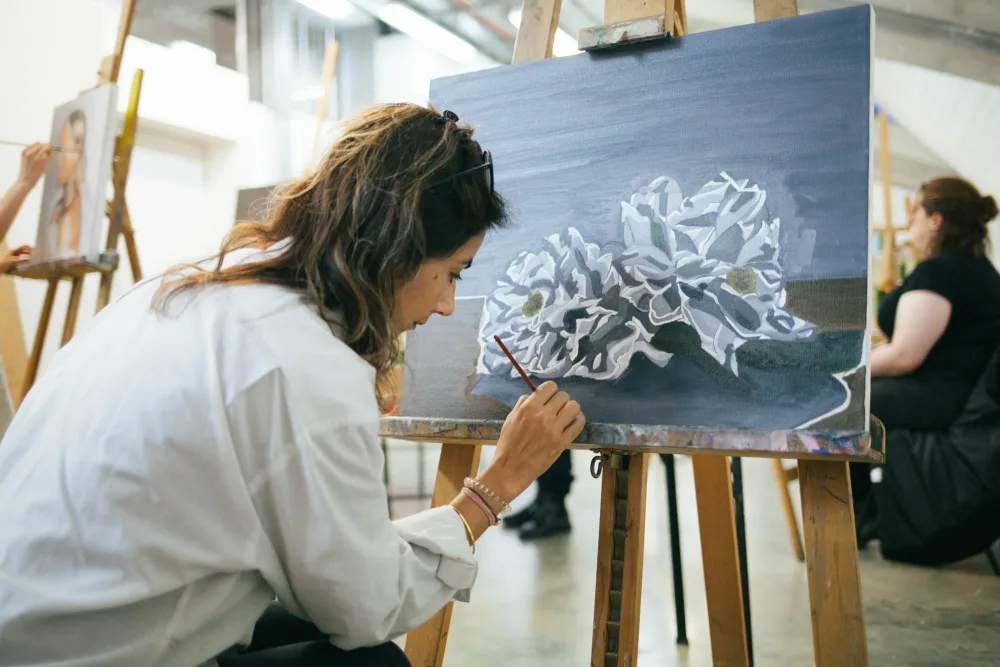The canvas is the perfect medium for expressing feelings, ideas, and creativity. It is possible to take lessons to either improve your existing painting abilities or discover something else. The guide presents a variety of painting techniques that beginners may explore in painting classes.
Brushwork Techniques
Mastering and understanding brushwork techniques is an essential aspect of painting. Painting classes usually begin with a brief introduction to the various types of brushes. Start with these basic brushwork methods:
- Stippling: Stippling uses small dots and short strokes to create patterns or textures. The technique is used to create texture on various parts of your paintings, like foliage, rock, and even the canvas’ surface.
- Blending: This is the act of blending colors to create a smooth transition. This technique can be used to produce realistic skin shades, subtle shadows, and gradients.
- Dry Brushing: This is the technique of using very little paint with a bristle brush to create a rough texture. It’s often used to simulate weathered and aged surfaces.
- Wet-On-Wet: A technique called Wet on Wet involves painting wet onto a previously wetted surface. Landscape and abstract artists often use the technique to achieve seamless color blending.
Acrylic Painting Techniques
Acrylic paint is an excellent choice for beginning artists because you can use it for many purposes, and it dries fast. In acrylic painting lessons, you can explore these techniques.
- Layering: Acrylic paints may be used to layer your artwork for it to have depth and complexity. For vibrant, rich colors, it is crucial to master the art of layering paint.
- Impasto: Impasto creates an effect that is three-dimensional, textured, and rich. The result is often to make certain areas of work stand out by using this technique.
- Glazing: This involves painting thin translucent layers over the dried layers. It creates luminous and transparent effects. It is often used to give a glassy or shiny appearance.
- Pouring: A trendy acrylic pouring technique where the paint is mixed up with a pouring medium and then poured onto the canvas. These unpredictable patterns can be mesmerizing.
- Sgraffito: Sgraffito allows you to scratch away a wet acrylic layer or a dried one, revealing the layers below. The result is a variety of textures, patterns, and shapes that add a new dimension to any artwork.
Watercolor Techniques
Watercolor paintings are known for their transparency and delicacy. Beginners can master the essential Watercolor techniques by taking painting classes.
- Wet-On-Dry: The technique is called Wet-On-Dry. In it, wet paint is applied to a dried paper surface. The technique works well for creating crisp lines and fine details in Watercolor art.
- Wet-On-Wet: This is the same as acrylic wet on dry, except that you use wet paint to create wet paper. The technique can be used for soft backgrounds and atmospheric effects.
- Lifting: Watercolours can easily be lifted by dabbing the paint with a sponge or brush dampened in water. This technique allows you to correct and highlight your painting.
- Masking: Masking involves the use of masking fluids or tapes to protect particular areas while painting. Remove the masking tape once you have finished painting to reveal crisp areas of white.
Mixed Media Techniques
Mixed media art combines various art forms and materials to create unique and innovative pieces. Painting classes may introduce you to mixed media techniques, such as:
- Collage: Incorporating pieces of paper, fabric, or other materials into your painting can add texture and depth to your artwork.
- Texture Paste: Texture paste can be applied to the canvas to create raised surfaces and interesting textures. It’s often used in abstract and contemporary art.
- Image Transfer: Image transfer techniques allow you to transfer images or text onto your painting surface. This can add a layer of narrative or intrigue to your artwork.
Palette Knife Techniques
Paintings that are bold and passionate can be made with a palette knife instead of a brush. Painting classes may teach you how to use a palette knife for:
- Thick Impasto: The palette knife is ideal for applying thick layers of paint, creating a sculptural effect on the canvas.
- Scumbling: Scumbling involves applying a thin, opaque layer of paint over a dry layer to create a hazy, blurred effect. It’s often used for creating atmospheric landscapes.
- Scraping: The palette knife can be used to scrape away layers of paint to reveal underlying colors or textures.
Conclusion
Exploring different painting techniques during painting classes is an exciting journey that allows beginners to unleash their creativity and develop their artistic skills. Whether you’re interested in traditional brushwork, acrylic, watercolor, mixed media, or palette knife techniques, there’s a wide array of methods to discover and experiment with in the world of painting. Join a painting class and enjoy your new artistic journey. You’ll be able to unlock your creativity and make beautiful art pieces that represent your style.




